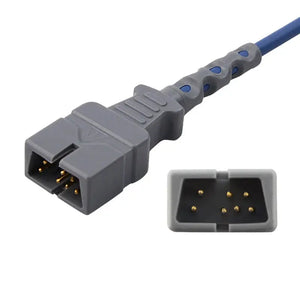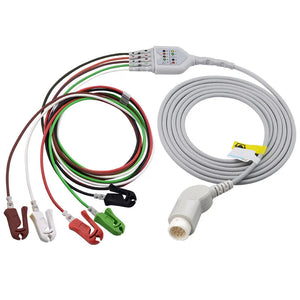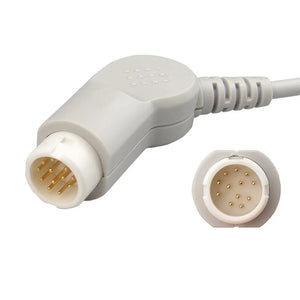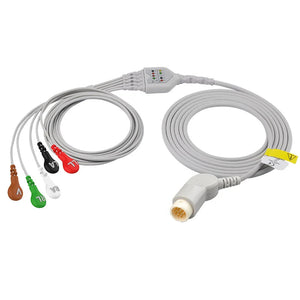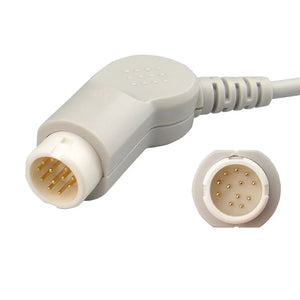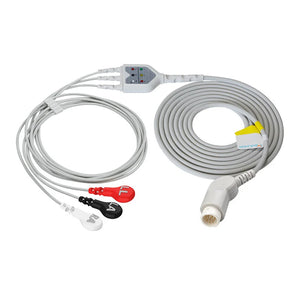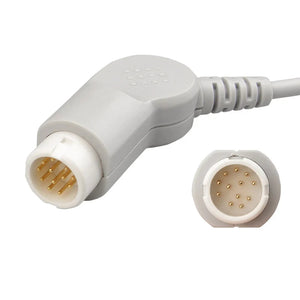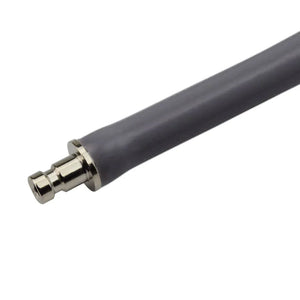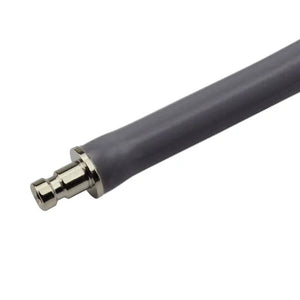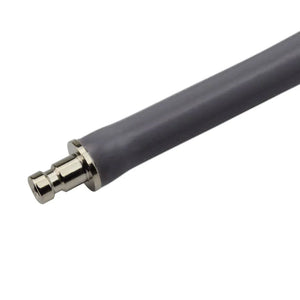Scope: U.S. hospitals, clinics, and biomedical repairers • Compliance-focused, action-first reference
Products referenced: MedLinket Reusable NIBP Cuffs, Hoses, Connectors
Quick Reference (At-a-Glance)
| Step | Action | Key Checks | Outcome |
|---|---|---|---|
| Pre-treatment | PPE on → Visual inspection → Wipe visible soil with damp cloth | Tears, loose hook-and-loop, frayed tubing, fluid ingress | Contamination contained; defective cuffs removed |
| Cleaning | Mild detergent (neutral pH) → Gentle agitation → Thorough rinse | No abrasive tools; no liquid into air pathway | Soils removed without material damage |
| Disinfection | Use compatible low-level disinfectant; honor contact time; final water wipe if required | Material compatibility; no residue left | Safe between-patient use |
| Dry & Reassemble | Air-dry fully → Reconnect hose/connector → Inflate ≥200 mmHg for 30 s leak check | No moisture trapped; no pressure decay | Restored function & hygiene |
| Storage | Hang or lay flat in ventilated cabinet; separate clean/dirty flows | Humidity control; avoid compression | Prevents recontamination & deformation |
Why Proper Cleaning Matters for Reusable NIBP Cuffs
Clean, intact cuffs protect patients and staff, reduce cross-contamination risk, and prevent false readings. MedLinket cuffs are engineered for durability and compatibility with common disinfectants when used as directed.
SOP: Step-by-Step Reprocessing Procedure
1) PPE & Pre-treatment
- Don gloves at minimum; add mask/eye protection for visible soil or splash risk.
- Isolate visibly soiled cuffs; place absorbent barrier under work surface.
- Visual inspection: tears, delamination, hook-and-loop wear, damaged printing, hose cracks, connector O-ring wear.
- Do not allow fluids into air pathway or monitor ports.
2) Disassembly (if applicable)
- Detach hose/connector (e.g., connectors), note orientation, and set aside.
- Separate metal (D-rings) vs polymer parts for appropriate treatment.
3) Cleaning (always before disinfection)
- Prepare neutral pH detergent per IFU; avoid phenolics/iodophors unless validated by manufacturer.
- Immerse or wipe (per IFU). Use soft brush on seams; no abrasive pads.
- Thorough rinse with clean water until suds-free.
4) Disinfection
- Apply compatible low-level disinfectant evenly; honor stated contact time.
- Remove residue with water wipe if IFU requires to protect skin and materials.
- For C. diff/visible blood: use upgraded protocol per facility policy.
5) Drying & Reassembly
- Air-dry fully in clean airflow; avoid heat that may deform polymers.
- Reconnect hose/connector; leak-check: inflate to ≥200 mmHg for 30 seconds—no noticeable pressure drop.
6) Storage & Documentation
- Store hanging or flat in a ventilated cabinet; segregate clean vs dirty.
- Log date, operator, method, disinfectant, pass/fail of leak-check.
✅ Do
- Clean → then disinfect (never reverse).
- Honor contact time on label.
- Leak-test after reassembly.
- Replace severely worn cuffs promptly.
⛔ Don’t
- Don’t submerge hose ports unless IFU permits.
- Don’t use abrasives or high-heat drying.
- Don’t mix clean and dirty flows.
Disinfectant × Material Compatibility Matrix
Use this compatibility snapshot to choose an appropriate disinfectant and exposure time. Always follow product IFUs.
| Cuff Surface / Part | Common Material | 70% IPA | Quat (per label) | Diluted Bleach* | Notes |
|---|---|---|---|---|---|
| Outer cuff fabric | Nylon/poly | ✔ Usually compatible | ✔ Compatible | ▲ Limited (color fade risk) | Wipe off residues; avoid over-wetting seams |
| Bladder (internal) | Latex-free elastomer | ✔ Surface wipe only | ✔ Surface wipe | ▲ Use only if required | Do not flood air path |
| Hoses / tubing | PU/PVC | ✔ Compatible wipe | ✔ Compatible wipe | ▲ Check color/print fastness | Avoid solvent pools near connectors |
| Connectors / D-rings | ABS/metal | ✔ Compatible | ✔ Compatible | ✔/▲ Varies by finish | Dry thoroughly to prevent corrosion |
*Use diluted sodium hypochlorite only when indicated by facility protocol; promptly rinse/wipe and dry to protect materials.
How Often Should You Clean?
| Scenario | Minimum Action | Notes |
|---|---|---|
| Between patients (routine) | Clean + low-level disinfect | Honor contact time; separate clean/dirty zones |
| Visible blood/body fluids | Upgraded protocol per facility (e.g., bleach), then rinse & dry | Dispose wipes as medical waste |
| Contact isolation (e.g., C. diff) | Facility-directed protocol; consider dedicated cuff | Document device assignment |
| Periodic QA | Quarterly pressure test; annual material audit | Retire if fail per criteria below |
Inspection & Retirement Criteria
Use this checklist to standardize pass/fail decisions. Attach photos to local SOP where required.
- Fabric/Seams: no tears, fraying, seam lift, delamination.
- Hook-and-loop: holds firmly for ≥500 cycles; no lint clogging.
- Printing: size/artery markers legible; IFU symbols visible.
- Hose/Connector: no cracks; O-rings intact; no fluid ingress.
- Leak test: no pressure drop ≥5 mmHg over 30 s at 200 mmHg.
Retire immediately for structural damage, persistent leaks, or illegible indicators impacting safe use.
Sizing & Fit (Accuracy First)
Choose cuff width ≈ 40% of arm circumference, bladder length ≈ 80% of arm circumference. Ensure the artery marker aligns correctly and the cuff fits snugly without gaps.
Common Mistakes & Troubleshooting
| Symptom | Likely Cause | Immediate Fix |
|---|---|---|
| Cannot reach target pressure | Leak at connector or bladder | Reseat connector/O-ring; replace damaged cuff/hose |
| Erratic readings | Wrong size; loose wrap; fluid ingress | Refit with correct size; inspect for moisture; dry/replace |
| Discoloration/stiffness post-clean | Incompatible disinfectant residue | Switch to compatible agent; add water wipe & full dry |
Standards & Compliance Mapping
Map policy text to actionable tasks your team can audit.
ANSI/AAMI/ISO 81060-2 (BP accuracy)
- Maintain cuff integrity and proper sizing to preserve accuracy.
- Document reprocessing that could affect measurement surfaces.
FDA/WHO Infection Control (general)
- Clean before disinfect; respect contact time; safe chemical handling.
- Standard & contact precautions; waste disposal per policy.
Local Facility Policy
- Define frequency by scenario; escalation for high-risk pathogens.
- Logs for traceability: date, operator, method, pass/fail.
Downloads & Templates
- Printable SOP (1-page) – workflow & Do/Don’t cards (add as PDF in Shopify Files and link here)
- Reprocessing Log (CSV) – date/operator/disinfectant/leak test
- Sizing Tape PDF – circumference → recommended cuff size
To add: upload files to Settings > Files and paste URLs here.
Reusable NIBP Cuffs: Frequently Asked Questions
Can I use bleach on cuffs?
Only when required by facility protocol and compatible with the cuff materials. Rinse/wipe and dry promptly to reduce color fading or fabric degradation.
What contact time should I use?
Follow the disinfectant label and the cuff manufacturer’s IFU. If in doubt, choose a compatible EPA-registered product and honor its contact time.
How do I check for leaks?
Attach to a manometer or monitor line, inflate to ≥200 mmHg, hold for 30 s. If pressure drops ≥5 mmHg, inspect connectors, O-rings, and bladder; replace if needed.




